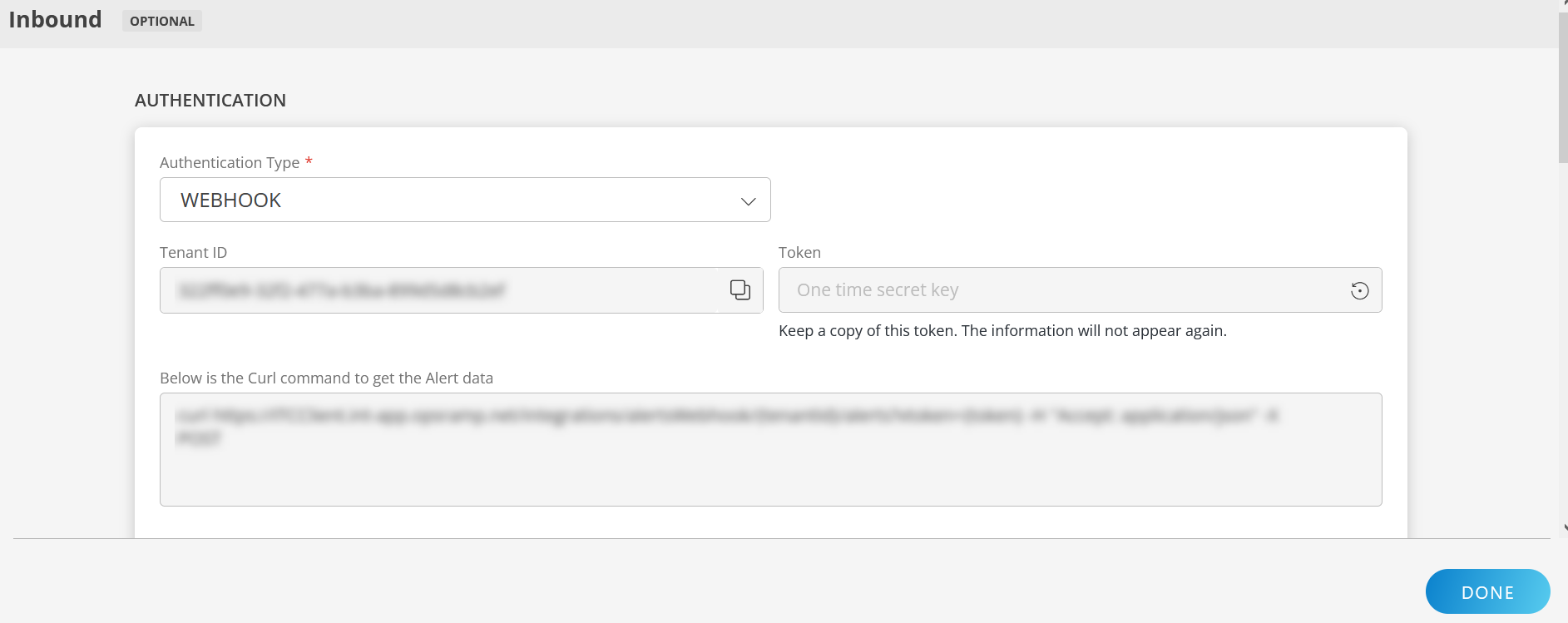Dynatrace monitors the response times and performance experienced in mobile and desktop browsers.
OpsRamp configuration
Step 1: Install the integration
- From All Clients, select a client.
- Navigate to Setup > Account.
- Select the Integrations and Apps tab.
- The Installed Integrations page, where all the installed applications are displayed. Note: If there are no installed applications, it will navigate to the Available Integrations and Apps page.
- Click + ADD on the Installed Integrations page. The Available Integrations and Apps page displays all the available applications along with the newly created application with the version.
- Search for the application using the search option available. Alternatively, use the All Categories option to search.
- Click ADD on the Dynatrace tile.
Inbound (Optional):

To configure the inbound, follow these steps:
Authentication:
Select the Authentication Type as Webhook.
- Webhook: By default, Webhook is selected as the Authentication Type.
Make a note of Tenant ID, Token and Webhook URL.
These details are used while creating an HTTP Request template during Dynatrace configuration.
- Webhook: By default, Webhook is selected as the Authentication Type.
Map Attributes: Map OpsRamp entity attributes with Dynatrace attributes.
Click +Add from the Map Attributes section.
From the Add Map Attributes window, enter the below information:
- OpsRamp Entity: Select Alert from the dropdown.
- OpsRamp Property: Select the OpsRamp property from the dropdown.
- Dynatrace Entity: Enter the Dynatrace entity value in the box and click the +value from the dropdown to add it. You can add multiple values.
- Dynatrace Property: Enter the Dynatrace property.
Parsing Condition:
- Click +Add and provide the parsing condition:
- Select an operator from the dropdown and enter a value in the fields accordingly. Based on the operator selected, the fields vary.
- Click Save. Click +Add to add more conditions.
Property Values:
- Click +Property Value.
- Enter a value in the Dynatrace Property Value box and select the appropriate value from the OpsRamp Property Value dropdown.
The options in the OpsRamp Property Value dropdown appear based on the OpsRamp Property selected. - Click Save.
- Click +Property Value to add more property values.
Default Value: Alternatively, you can enter/select a default value in the box.
Note: To map more attributes, click +Entity.
Click Add Map Attributes. The mapped attributes list is added.
- Click the three dots icon at the end of each row to edit or remove the map attributes.
- Use the Filter option to filter the map attributes.
Additional Settings: Select the Drop alerts from unmanaged resources checkbox if you do not want to trigger alerts from unmanaged resources.
Enrich and Create Alert: Select a process definition from the dropdown. You can customize the incoming alerts according to the properties defined in the process definition.
Click Finish.
The following table shows the attribute mappings:
| Third-Party Entity | OpsRamp Entity | Third-Party Property | OpsRamp Property | Third-Party Property Value | OpsRamp Property Value |
|---|---|---|---|---|---|
| Alert | ALERT | ProblemSeverity | alert.currentState | AVAILABILITY | Ok |
| Alert | ALERT | ProblemSeverity | alert.currentState | ERROR | Critical |
| Alert | ALERT | ProblemSeverity | alert.currentState | PERFORMANCE | Info |
| Alert | ALERT | ProblemSeverity | alert.currentState | RESOURCE_CONTENTION | Warning |
| Alert | ALERT | ProblemDetailsText | alert.description | NA | NA |
| Alert | ALERT | ImpactedEntity | alert.deviceName | NA | NA |
| Alert | ALERT | ProblemImpact | alert.serviceName | mytest | Test |
| Alert | ALERT | State | alert.subject | NA | NA |
- You can modify the attributes at any time.
- You need not follow the same mappings.
Dynatrace configuration
Step 1: Configure alerts
- Log into Dynatrace Admin UI.
- Go to Integrations > Problem Notification, select + Set up notification and enter:
- Name
- Webhook URL: Paste the Webhook URL that you generated from OpsRamp inbound configuration.
- Custom payload: Enter the payload.
- Default for Alert Profiling
- Click Send test notification.
- The Set up notifications screen helps Dynatrace integrate with other notification systems.
- The Custom Integration area displays a problem notification setup screen.
- The
ImpactedEntitiesandProblemDetailsJSONvalues are JSON data types and must not have quotes around them. - The Save button is displayed only if send test notification is successful.
Example payload:
{
"State": "OPEN",
"ProblemID": "999",
"ProblemTitle": "Dynatrace problem notification test run",
"ImpactedEntity": "Myhost1, Myservice1",
"ProblemSeverity": "ERROR",
"ProblemDetailsText": "Dynatrace problem notification test run details",
"ProblemImpact": "INFRASTRUCTURE"
}Step 2: Configure alerting profiles
- Go to Dynatrace Home Settings > Alerting.
- Select Alerting Profiles, enter a name and click Create.
- On the <Test 1> page, create the required alerting rule and event filter and click Done.